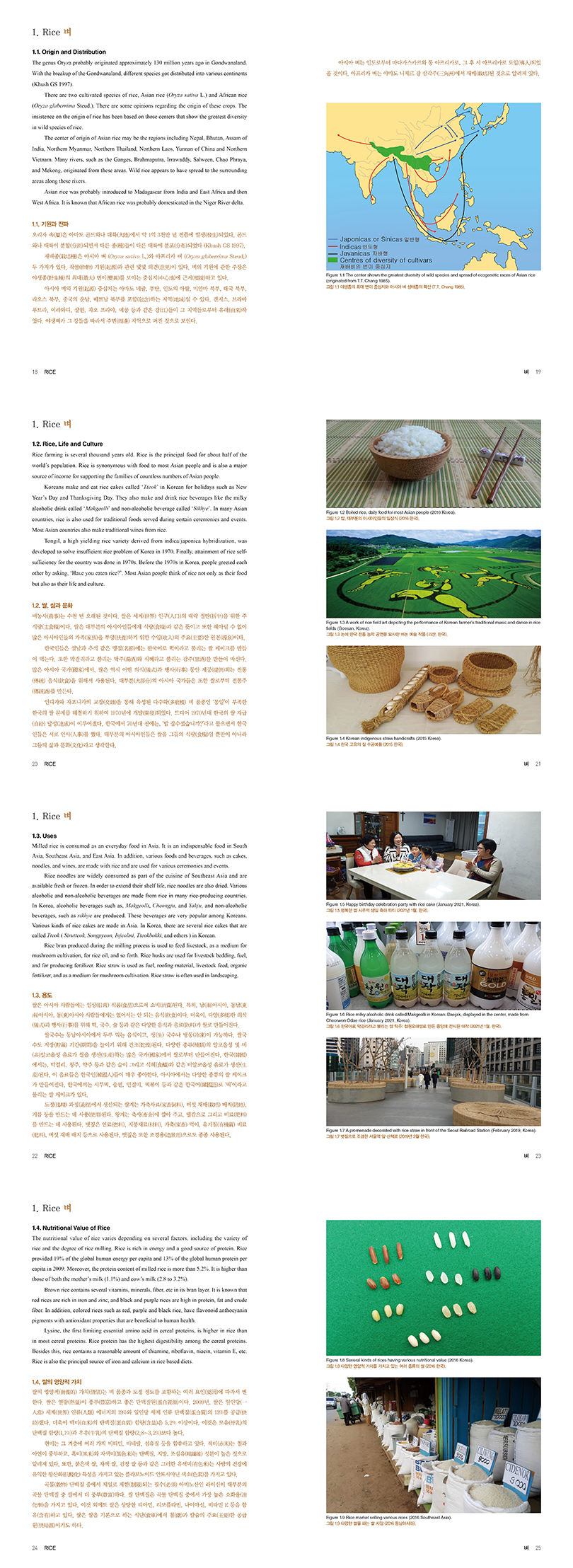
저자(글) 유해영
인물 상세 정보Ph.D in Plant breeding
식물육종학 박사
National Institute of Crop Science, Rural Development Administration
Republic of Korea, Senior agricultural researcher(1980∼2008)
국립식량과학원 농촌진흥청, 대한민국, 농업연구관(1980~2008)
상담 가능 시간
평일 오전 9시 ~ 오후 6시 (점심 시간 12 ~ 1시 제외)
주말, 공휴일은 이메일로 문의부탁드립니다

Most Asian people think of rice not only as their food but also as their life and culture.
대부분의 아시아인들은 쌀을 그들의 식량(食糧)일 뿐만이 아니라
그들의 삶과 문화(文化)라고 생각한다.
Preface 머리말 4
Acknowledgments 감사의 글 6
1. RICE
벼 17
1.1. Origin and Distribution 기원과 전파 18
1.2. Rice, Life and Culture 쌀, 삶과 문화 20
1.3. Uses 용도 22
1.4. Nutritional Value of Rice 쌀의 영양적 가치 24
1.5. Rice-Growing Regions 벼 재배 지역 26
1.6. Rice Production 벼 생산 28
1.7. Cultivated Rice 재배 벼 30
2. MORPHOLOGY AND STRUCTURE OF RICE
벼의 형태와 구조 33
2.1. Morphology of Cultivated Rice 재배 벼의 형태 34
2.2. Seed 종자 36
2.2.1. Multiformity of seeds 종자의 다양성 36
2.2.2. Structure of a seed 종자의 구조 38
2.3. Leaf 잎 40
2.3.1. Structure of a leaf 잎의 구조 40
2.3.2. Leaves of a rice seedling 벼 유묘의 잎 42
2.3.3. Leaves of a mature plant 성숙한 개체의 잎 44
2.3.4. Leaf development 잎 발달 46
2.3.5. Leaves as carbohydrate factories 탄수화물 공장으로서의 잎 48
2.4. Root 뿌리 50
2.4.1. Three types of rice roots 세 가지 종류의 벼 뿌리 50
2.4.2. Crown roots 관근 52
2.4.3. Root function 뿌리 기능 54
2.5. Culm 줄기 56
2.6. Panicle 이삭 58
2.7. Spikelet 소수 60
2.8. Grain 종실 62
3. GROWTH AND DEVELOPMENT OF RICE
벼의 생장과 발달 65
3.1. Life Cycle of a Rice Plant 벼 식물체의 생활주기 66
3.2. Growth Phases 생장 상 68
3.2.1. Vegetative growth period 영양생장기 68
3.2.2. Reproductive growth period 생식생장기 70
3.2.3. Ripening period 등숙기 72
3.3. Germination Requirement 발아 요건 74
3.3.1. Germination 발아 74
3.3.2. Water 수분 76
3.3.3. Temperature 온도 78
3.3.4. Oxygen 산소 79
3.4. Seedling Growth 유묘 생장 80
3.4.1. Source of nutrients for growth 생장을 위한 양분의 원천 80
3.4.2. Flooding depth 담수 깊이 82
3.4.3. Water regime 수분 상태 84
3.4.4. Temperature 온도 86
3.4.5. Fertilization 시비 87
3.4.6. Sunlight 햇빛 88
3.5. Rooting 뿌리내림 90
3.5.1. Root development 뿌리 발달 90
3.5.2. Factors affecting root development 뿌리 발달에 영향하는 요인 92
3.5.3. Root development and surface soil 뿌리 발달과 작토 94
3.5.4. Root development and plowing 뿌리 발달과 경운 96
3.5.5. Root development and fertilization 뿌리 발달과 시비 98
3.6. Tillering 분얼 100
3.6.1. Increase of tiller number 분얼경 수의 증가 100
3.6.2. Tillering pattern 분얼 패턴 102
3.6.3. Factors related to tillering 분얼에 관련되는 요인 104
3.6.4. Effect of variety on tillering 분얼에 대한 품종의 영향 106
3.6.5. Effect of planting density on tillering 분얼에 대한 재식밀도의 영향 108
3.6.6. Effect of planting season on tillering 분얼에 대한 재식계절의 영향 110
3.6.7. Fertilizer application level on tillering 분얼에 대한 시비 수준 112
3.7. Development of Panicle and Grain 이삭과 종실의 발달 114
3.7.1. Panicle initiation 유수 분화 114
3.7.2. Anthesis 개화 116
3.7.3. Flowering order 개화 순서 118
3.7.4. Factors affecting grain development 종실 발달에 영향을 주는 요인 120
4. PADDY FIELD PREPARATION
논 준비 123
4.1. Levee Repair 논둑 보수 124
4.2. Plowing 경운 126
4.3. Harrowing and Leveling 써레질과 균평작업 128
5. RAISING RICE SEEDLINGS
벼 육묘 131
5.1. Seed Preparation 종자 준비 132
5.1.1. Seed selection 종자 선발 132
5.1.2. Dormancy break 휴면 타파 134
5.1.3. Disinfection and soakage 소독과 침지 136
5.1.4. Pre-germination 싹 틔우기 138
5.2. Methods of Raising Seedlings 육묘 방법 140
5.3. Wetbed Method 무논 못자리 방법 142
5.3.1. Selection of the appropriate location 알맞은 장소 선택 142
5.3.2. Preparation of the land 포장 준비 144
5.3.3. Construction of the seedbed 못자리 설치 146
5.3.4. Sowing of the seeds 종자 파종 148
5.3.5. Management of the seedbed 못자리 관리 150
5.3.6. Nursery period and preparation for planting 못자리 기간과 이앙 준비 152
5.4. Drybed Method 마른 못자리 방법 154
5.5. Dapog Method 다폭 못자리 방법 156
5.5.1. Dapog seedbed 다폭 못자리 156
5.5.2. Preparation of the land 포장 준비 158
5.5.3. Construction of the seedbed 못자리 설치 160
5.5.4. Preparation of the seed sowing room 종자 파종실 준비 162
5.5.5. Sowing of the seeds 종자 파종 164
5.5.6. Management of the seedbed 못자리 관리 166
6. RICE TRANSPLANTING
벼 이앙 169
6.1. Advantages of Transplanting 이앙의 장점 170
6.2. Methods of Transplanting 이앙 방법 172
6.3. Random Transplanting 막모 이앙 174
6.4. Straight Row Planting with Planting Guides 식재 가이드를 이용한 줄모 이앙 176
6.4.1. Materials 재료 176
6.4.2. Establishment of baselines 기준선 설치 178
6.4.3. Setting of the planting guides 식재 가이드 설치 180
6.4.4. Planting of seedlings 유묘 이앙 182
6.5. Straight Row Planting with a Marker 마커를 활용한 줄모 이앙 184
6.5.1. Markers 마커 184
6.5.2. Establishment of baselines 기준선 설치 186
6.5.3. Marking of the field 포장 눈금 매김 188
6.5.4. Planting of seedlings 유묘 이앙 190
6.6. Spacing of Transplanting 이앙 간격 192
6.7. Depth of Transplanting 이앙 깊이 194
6.8. Number of Planting Seedlings per Hill 주당 식재 유묘 수 196
6.9. Cutting of Leaves before Transplanting 이앙 전 잎 자르기 198
6.10. Replanting at Missing Hill 결주 보식 200
7. DIRECT SEEDING OF RICE
벼 직파 203
7.1. Advantages of Direct Seeding 직파의 장점 204
7.2. Methods of Direct Seeding 직파 방법 206
7.3. Direct Seeding on Wetlands 습답 직파 208
7.3.1. Broadcasting on puddled fields 무논 산파 208
7.3.2. Drilling on puddled fields 무논 조파 210
7.3.3. Broadcasting in flooded fields 담수 산파 212
7.3.4. Hill seeding in puddled fields 무논 점파 214
7.4. Direct Seeding on Drylands 마른 땅 직파 216
7.4.1. Direct seeding in dry paddy fields 건답 직파 216
7.4.2. Dibbling in mountainous uplands 산간지 점파 218
7.4.3. Direct seeding in upland fields 밭 직파 220
8. RICE MACHINE TRANSPLANTING
벼 기계 이앙 223
8.1. Machine Transplanting 기계 이앙 224
8.2. Types of Transplanters 이앙기의 종류 226
8.3. Raising of Rice Seedlings 육묘 228
8.3.1. Preparation of nursery soil 상토 준비 228
8.3.2. Sowing of the seeds 102 종자 파종 230
8.3.3. Management of the seedbed 못자리 관리 232
8.4. Preparation of the Field 포장 준비 234
8.5. Transplanting of Seedlings 유묘 이앙 236
9. FERTILIZER APPLICATION
비료 시용 239
9.1. Essential Elements 필수 원소 240
9.2. Fertilizers 비료 242
9.3. Source of Fertilizers 비료의 공급원 244
9.3.1. Organic fertilizers 유기질 비료 244
9.3.2. Inorganic fertilizers 무기질 비료 246
9.4. Compost 퇴비 248
9.4.1. Benefits 이로운 점 248
9.4.2. Essential elements for composting 퇴비화를 위한 필수 요소 250
9.4.3. Materials 재료 252
9.4.4. How to make compost 퇴비 제조법 254
9.5. Nitrogen 질소 256
9.5.1. Function 기능 256
9.5.2. Fertilizer efficiency 비료 효율 257
9.5.3. Time of application 시비 시기 258
9.5.4. Application amount and methods 시비량과 방법 260
9.5.5. Season and fertilization 계절과 시비 262
9.5.6. Soil fertility and fertilization 토양 비옥도와 시비 264
9.5.7. Variety and fertilization 품종과 시비 266
9.6. Phosphorus 인 268
9.6.1. Function 기능 268
9.6.2. Application amount 시비량 269
9.6.3. Application methods 시비 방법 270
9.7. Potassium 칼륨 272
9.7.1. Function 기능 272
9.7.2. Application amount 시비량 273
9.7.3. Application methods 시비 방법 274
10. WATER MANAGEMENT
물 관리 277
10.1. Role of Water 물의 역할 278
10.2. Source and Loss of Water 물의 원천과 손실 280
10.3. Water Management 물 관리 282
11. WEED CONTROL
잡초 방제 285
11.1. Harmful Effect of Weeds 잡초의 악영향 286
11.2. General Types of Weeds 잡초의 일반적 유형 288
11.2.1. Habitat 서식지 288
11.2.2. Life cycle 생활 주기 290
11.2.3. Morphology 형태 292
11.3. Rice-Weed Competition 벼 잡초 경합 294
11.4. Rice Plants and Barnyard Grasses 벼 식물체와 피 296
11.5. Proper Time of Weeding 제초의 적기 298
11.6. Methods of Weed Control 잡초 방제 방법 300
11.6.1. Preventive methods 예방적 방법 300
11.6.2. Cultural methods 재배적 방법 302
11.6.3. Hand and mechanical weeding 손 및 기계적 제초 304
11.6.4. Biological methods 생물적 방법 306
11.6.5. Use of herbicide 제초제 사용 308
11.6.6. Integrated weed management 종합적 잡초 관리 310
12. DISEASE AND PEST MANAGEMENT
병해충 및 유해 소동물 관리 313
12.1. Diseases 병 314
12.1.1. Rice diseases 벼 병 314
12.1.2. Symptoms 증상 316
12.2. Insect Pests 해충 318
12.2.1. Insect pests in rice 벼 해충 318
12.2.2. Damages 피해 320
12.3. Disease and Insect Pest Control 병해충 방제 322
12.3.1. Cultural and mechanical methods 재배적 및 기계적 방법 322
12.3.2. Variety selection 품종 선택 324
12.3.3. Biological control 생물적 방제 326
12.3.4. Chemical control 화학적 방제 328
12.3.5. Integrated pest management 종합적 병해충 관리 330
12.4. Birds 조류 332
12.4.1. Birds and the damage 조류와 그 피해 332
12.4.2. Control methods 방제 방법 334
12.5. Rats 쥐류 336
12.5.1. Rats and the damage 쥐류와 그 피해 336
12.5.2. Control methods 방제 방법 338
12.6. Snails 우렁이 340
12.6.1. Snails and the damage 우렁이와 그 피해 340
12.6.2. Control methods 방제 방법 342
13. POSTPRODUCTION OPERATION
생산 후 작업 345
13.1. Harvesting 수확 346
13.2. Threshing 탈곡 348
13.3. Drying 건조 350
13.4. Cleaning 정선 352
13.5. Storage 저장 354
13.6. Milling 도정 356
13.7. Parboiling 찐쌀 만들기 358
13.8. Utilization of Rice Straw 볏짚 이용 360
13.9. Evaluating Eating Quality of Rice 쌀의 식미 평가 362
14. RICE SEED PRODUCTION
벼 종자 생산 365
14.1. Systems of Seed Multiplication 종자 증식 체계 366
14.2. Standards of Seed Certification 종자 보증 기준 368
14.3. Fields and Methods for Seed Production 종자 생산을 위한 포장 및 방법 370
14.3.1. Fields for seed production 종자 생산을 위한 포장 370
14.3.2. Cultivation practices 재배 방법 372
14.3.3. Elimination of off-types 이형개체의 제거 374
14.3.4. Postproduction practices 생산 후 처리 방법 376
15. RICE FARMING IN KOREA
한국의 벼농사 379
15.1. Natural Environment of Korea 한국의 자연 환경 380
15.2. Rice Farming Climate Zone 벼농사 기후 지대 384
15.3. Changes of Rice Farming 벼농사의 변천 388
15.4. the Green Revolution in Korea 한국의 녹색혁명 392
15.4.1. the Green Revolution in Korea 한국의 녹색혁명 392
15.4.2. Development of Tongil rice variety 통일 벼 품종 개발 395
15.4.3. Innovation of rice cultivation technology 벼 재배기술 혁신 398
15.4.4. ?Government employees’ dedication to the Green Revolution
녹색혁명에 대한 공직자의 헌신 401
15.5. Rice Variety Development in Korea 한국의 벼 품종 육성 406
15.6. ?Establishment of Rice Machine Transplanting Cultivation Technology
벼 기계이앙 재배기술 확립 410
15.7. Mechanization of Rice Farming Works 벼농사 작업의 기계화 413
15.8. Recent Rice Farming in Korea 근년 한국의 벼농사 416
15.9. Research Agencies Related to Rice Farming 벼농사 관련 연구기관 419
15.9.1. Central government research institutes 중앙정부 연구기관 419
15.9.2. Local government research institutes 지방정부 연구기관 423
References 참고 문헌 428
About the author 저자 소개 430